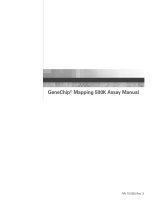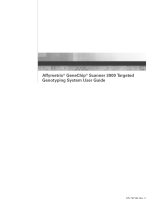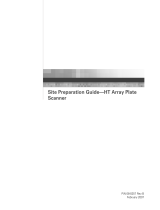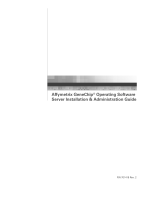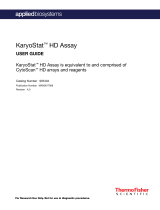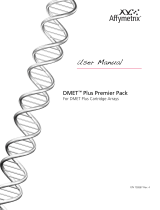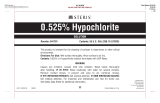Page is loading ...

For Research Use Only.
Not for use in diagnostic procedures.
701684 Rev. 3
GeneChip
Mapping 100K
Assay Manual
®

Trademarks
Affymetrix®, GeneChip®,®,,
®, GenFlex®, MicroDB™, Jaguar™,
Flying Objective™, NetAffx™, CustomExpress®, CustomSeq™, HuSNP®, ‘Tools To Take You
As Far As Your Vision®’, and ‘The Way Ahead™’ are trademarks owned or used by Affymetrix,
Inc.
QIAGEN is a registered trademark of QIAGEN GmbH, Hilden Germany.
Limited License
FOR RESEARCH AND/OR ANALYTE SPECIFIC REAGENT USE ONLY:
EXCEPT AS EXPRESSLY SET FORTH HEREIN, NO RIGHT TO COPY, MODIFY,
DISTRIBUTE, MAKE DERIVATIVE WORKS OF, PUBLICLY DISPLAY, MAKE, HAVE
MADE, OFFER TO SELL, SELL, USE, OR IMPORT PROBE ARRAYS OR ANY OTHER
PRODUCT IS CONVEYED OR IMPLIED WITH THE PROBE ARRAYS, INSTRUMENTS,
SOFTWARE, REAGENTS, OR ANY OTHER ITEMS PROVIDED HEREUNDER. EXCEPT
FOR CERTAIN ARRAYS AND REAGENTS DESIGNATED AS "ANALYTE SPECIFIC
REAGENTS" (SEE APPLICABLE PACKAGE INSERT) WHICH ARE LICENSED FOR
USE AS ANALYTE SPECIFIC REAGENTS OR RESEARCH USE, ALL PRODUCTS
(INCLUDING THE PROBE ARRAYS, INSTRUMENTS, SOFTWARE, AND REAGENTS)
DELIVERED HEREUNDER ARE LICENSED TO BUYER FOR RESEARCH USE ONLY.
THIS LIMITED LICENSE PERMITS ONLY THE USE BY BUYER OF THE PARTICULAR
PRODUCT(S), IN ACCORDANCE WITH THE WRITTEN INSTRUCTIONS PROVIDED
THEREWITH, THAT BUYER PURCHASES FROM AFFYMETRIX (AFX) OR ITS
AUTHORIZED REPRESENTATIVE. THE PURCHASE OF ANY PRODUCT(S) DOES NOT
BY ITSELF CONVEY OR IMPLY THE RIGHT TO USE SUCH PRODUCT(S) IN
COMBINATION WITH ANY OTHER PRODUCT(S). IN PARTICULAR, (i) NO RIGHT TO
MAKE, HAVE MADE, OR DISTRIBUTE OTHER PROBE ARRAYS IS CONVEYED OR
IMPLIED BY THE PROBE ARRAYS, (ii) NO RIGHT TO MAKE, HAVE MADE, IMPORT,
DISTRIBUTE, OR USE PROBE ARRAYS IS CONVEYED OR IMPLIED BY THE
INSTRUMENTS OR SOFTWARE, AND (iii) NO RIGHT TO USE PROBE ARRAYS IN
COMBINATION WITH INSTRUMENTS OR SOFTWARE IS CONVEYED UNLESS ALL
COMPONENT PARTS HAVE BEEN PURCHASED FROM AFX OR ITS AUTHORIZED
REPRESENTATIVE. FURTHERMORE, PROBE ARRAYS DELIVERED HEREUNDER
ARE LICENSED FOR ONE (1) TIME USE ONLY AND MAY NOT BE REUSED. THE
PRODUCTS DO NOT HAVE FDA APPROVAL. NO PATENT LICENSE IS CONVEYED TO
BUYER TO USE, AND BUYER AGREES NOT TO USE, THE PRODUCTS IN ANY
SETTING REQUIRING FDA OR SIMILAR REGULATORY APPROVAL OR EXPLOIT
THE PRODUCTS IN ANY MANNER NOT EXPRESSLY AUTHORIZED IN WRITING BY
AFX IN ADVANCE.
Patents
Arrays: Products may be covered by one or more of the following patents and/or sold under
license from Oxford Gene Technology: U.S. Patent Nos. 5,445,934; 5,744,305; 6,261,776;
6,291,183; 5,700,637; 5,945,334; 6,346,413; 6,399,365; and 6,610,482; and EP 619 321; 373
203 and other U.S. or foreign patents.
Copyright
©2004 Affymetrix, Inc. All rights reserved.

i
Introduction
This manual serves as a guide for technical personnel conducting
GeneChip® Mapping 100K experiments in the laboratory. It contains
protocols for sample preparation, array hybridization, information for
washing, staining, and scanning arrays and generating genotype
calls. It also includes extensive troubleshooting information. This
technical manual is divided into chapters which describe in detail
specific aspects of the GeneChip Mapping 100K Assay. A description
of each chapter follows.
Chapter 1: Scientific Overview. A description of the overall concept
behind the GeneChip Mapping assay, including the biochemical process,
data generation, potential applications, and a list of references.
Chapter 2: Laboratory Setup. An explanation of the appropriate
laboratory configuration for running GeneChip Mapping 100K experiments
including how to set up a workflow to minimize the possibility of carryover
contamination.
Chapter 3: Genomic DNA Preparation. The requirements for genomic
DNA, with recommended sources and methods for purification and
quantitation.
Chapters 4: Experimental Protocols. Detailed, step-by-step protocols for
preparation of sample from genomic DNA, including restriction digestion,
adaptor ligation, amplification, purification, quantitation, fragmentation,
labeling and array hybridization. A description of quality control
checkpoints included at various stages of the protocol which enable array
performance to be monitored.
Chapter 5: Washing, Staining, and Scanning. Basic protocols for fluidics
station and scanner operation.

ii
Chapter 6: Fluidics Station Maintenance Procedures. Describes a weekly
fluidics station bleach protocol and a monthly fluidics station
decontamination protocol.
Chapter 7: Analysis Workflow and Guidelines for Assessing Sample and
Data Quality. Describes the analysis workflow in GCOS and GDAS, and
provides information for assessing data quality.
Chapter 8: Troubleshooting. Additional guidelines for obtaining optimal
assay results including troubleshooting tips.
Chapter 9: Reagents, Instruments, and Supplies. A complete list of the
reagents required for the GeneChip Mapping Assay including those
provided in the assay kit and recommended suppliers of supplementary
items.

iii
Contents
CHAPTER 1 Scientific Overview 3
References 6
CHAPTER 2 Laboratory Setup 13
Pre-PCR Clean Room 14
PCR Staging Room 14
Main Lab 14
Safety Precautions 16
CHAPTER 3 Genomic DNA Preparation 19
General Requirements for Human Genomic DNA 20
Sources of Human Genomic DNA 21
Genomic DNA Extraction / Purification Methods 21
DNA Cleanup 22
References 22

CONTENTS
iv
CHAPTER 4 GeneChip® Mapping Assay Protocol 27
Introduction 27
Assay Overview 28
Genomic DNA Preparation 29
Preparation of Genomic DNA 29
Reagents 29
STEP 1: Reagent Preparation and Storage 29
STEP 2: Restriction Enzyme Digestion 30
Reagents and Equipment 30
Digestion Procedure 31
Pre-PCR Clean Area 31
PCR Staging Area 32
STEP 3: Ligation 33
Reagents and Equipment 33
Ligation Procedure 33
Pre-PCR Clean Area 33
PCR Staging Area 34
STEP 4: PCR 36
Reagents and Equipment 36
PCR Procedure 38
Pre-PCR Clean Room 38
PCR Staging Area 39
Main Lab 39
STEP 5: PCR Purification and Elution with QIAGEN
MinElute™ 96 UF PCR Purification Plate 42
Reagents and Equipment 42
STEP 6: Quantification of Purified PCR Product 44

GeneChip® Mapping 100K Assay Manual v
STEP 7: Fragmentation 45
Reagents and Equipment 45
Main Lab 45
Fragmentation Procedure 46
STEP 8: Labeling 49
Reagents 49
Labeling Procedure 49
Main Lab 49
STEP 9: Target Hybridization 51
Reagents 51
Reagent Preparation 51
Hybridization Procedure 52
CHAPTER 5 Mapping Arrays: Washing, Staining,
and Scanning 57
Reagents and Materials Required 58
Reagent Preparation 59
Experiment and Fluidics Station Setup 61
Step 1: Registering a New Experiment in GCOS 61
Step 2: Preparing the Fluidics Station 62
Probe Array Wash and Stain 64
Washing and Staining the Probe Array Using FS-450/250 68
Washing and Staining the Probe Array Using FS-400 70
Probe Array Scan 72
ScannerUpdate Application 72
Handling the GeneChip® Probe Array 72
Scanning the Probe Array 74
Shutting Down the Fluidics Station 75
Customizing the Protocol 76

CONTENTS
vi
CHAPTER 6 Fluidics Station Maintenance Procedures 81
Weekly Fluidics Station Cleanout 81
Bleach Protocol 81
Monthly Fluidics Station Decontamination Protocol 88
CHAPTER 7 Analysis Workflow and Guidelines
for Assessing Data Quality 93
Software Requirements 93
Analysis Workflow 94
Analysis 96
Report 98
Output 100
Additional Functionality 102
Import Sample Attributes 102
Examining the Raw Probe Data 103
Export 103
NetAffx™ SNP Annotation 103
Assessing Data Quality 105
Call Rate 106
MPAM SNPs for Detecting Sample Contamination 110
Oligonucleotide Controls 111
Check Consistency Between Xba and Hind Arrays
Using Shared SNP Patterns 112
B2 Oligo Performance 113
Concordance with Reference Genotypes on Reference Genomic DNA 103 114
Downstream Analysis Considerations 115

CONTENTS
viii

1

Chapter 1

3
Scientific Overview
The discovery of millions of single-nucleotide polymorphisms (SNPs) in the
human genome has been received by the scientific community with great
enthusiasm. This large repository of markers for human variation allows
innovations in genotyping technologies and construction of increasingly
dense SNP maps and other tools. These tools have the potential of enabling
investigators to map complex human genetic traits, to understand the history
of human populations, and to examine chromosomal copy number changes
that lead to cancer and other diseases, all at unprecedented resolution.
One such tool is the Affymetrix GeneChip® Mapping 100K Set, which can
genotype more than 100,000 SNPs on two arrays, using a single polymerase
chain reaction (PCR) primer. As its name implies, it is a mapping tool
designed to identify regions of the genome linked to or associated with a
particular trait or phenotype. Additionally, it is useful for determination of
allele frequencies in various populations and for mapping regions with loss
of heterozygosity during cancer progression.
Currently, millions of common human SNPs have been identified (The
International HapMap Consortium, 2003, Sachidanandam, et al. 2001).
The large numbers of SNPs available will allow for higher-density, genome-
wide mapping sets, which in turn will increase the amount of information
that can be extracted for linkage and association studies. Additionally, a
higher density of SNPs increases the proportion of linkage disequilibrium
(LD) measured in the sample. While detailed LD information will soon
become available for major population groups as a result of the HAPMAP
project (The International HapMap Consortium, 2003, Sachidanandam,
et al. 2001), there will also be a need to map and measure blocks of LD in
isolated populations. Hundreds of thousands of SNPs are predicted to be
necessary to capture LD for mapping complex diseases. In studies of cancer
where there is chromosomal instability, denser sets of markers will allow
finer resolution in determining the borders of chromosomal losses and gains.
These and other studies will benefit as denser SNP marker sets become
available.

4
The challenge faced by researchers today is that the scoring of these SNPs
by currently available methods is labor intensive and requires a substantial
level of automation. While a variety of robust genotyping technologies do
exist for scoring SNPs, most require 2-6 oligonucleotides to amplify the
locus and to discriminate alleles. Clearly such methods are costly and
difficult to scale to > 100,000 SNPs.
The GeneChip Mapping Assay eliminates these bottlenecks because the
assay does not require robots or automation. Instead, the GeneChip Mapping
Assay takes advantage of GeneChip brand microarrays by coupling a highly
reproducible generic sample preparation method with allele-specific
hybridization (Kennedy, et al. 2003; Matsuzaki, et al. 2004). Whole genome
sampling analysis (WGSA) is a highly-scalable method for genotyping
SNPs on synthetic oligonucleotide arrays. This method was used initially to
develop one primer 10,000 SNP assay (Mapping 10K) and has now been
scaled to genotype > 100,000 SNPs on two arrays (GeneChip® Human
Mapping 50K Array Xba 240 and the GeneChip® Human Mapping 50K
Array Hind 240).
This genotyping approach satisfies three important criteria. First, sample
preparation avoids the use of individual SNP-specific primers. Second, the
reduction and amplification is highly reproducible, capturing a majority of
the same SNPs across many samples. Finally, the method produces highly
accurate genotype calls (Matsuzaki, et al. 2004, Middleton, et al. 2004).
The GeneChip Mapping Assay is outlined in Figure 1.1. After in silico
prediction of SNPs residing in desired genomic fractions, oligonucleotides
corresponding to these SNP-containing fragments were used to design high-
density microarrays. Following biochemical fractionation that mirrors the
in silico fractionation, the target is hybridized to arrays and SNPs are
genotyped by allele-specific hybridization.

GeneChip® Mapping 100K Assay Manual 5
Figure 1.1
GeneChip Mapping Assay Strategy
Figure 1.2
GeneChip Mapping Assay - Xba I
In silico fractionation
Synthesis of predicted fragments on microarrays
Biochemical fractionation
Allele specific hybridization and Genotype Calling

References
6
References
Ardlie K.G., Kruglyak L., Seielstad M. Patterns of linkage disequilibrium in
the human genome. Nat Rev Genet. 3: 299-309 (2002).
Bignell G.R., Huang J., Greshock J., Watt S., Butler A., West S., Grigorova
M., Jones K.W., Wei W., Stratton M.R., Futreal P.A., Weber B., Shapero
M.H., Wooster R. High-resolution analysis of DNA copy number using
oligonucleotide microarrays. Genome Res. 14: 287-295 (2004).
Botstein D., Risch N. Discovering genotypes underlying human phenotypes:
past successes for Mendelian disease, future approaches for complex
disease. Nat Genet. 33 Suppl: 228-237 (2003).
Carlson C.S., Eberle M.A., Rieder M.J., Yi Q., Kruglyak L., Nickerson D.A.
Selecting a maximally informative set of single-nucleotide polymorphisms
for association analyses using linkage disequilibrium. Am J Hum Genet. 74:
106-120 (2004).
Figure 1.3
GeneChip Mapping Assay - Hind III

GeneChip® Mapping 100K Assay Manual 7
Crawford D.C., Carlson C.S., Rieder M.J., Carrington D.P., Yi Q., Smith
J.D., Eberle M.A., Kruglyak L., Nickerson D.A. Haplotype diversity across
100 candidate genes for inflammation, lipid metabolism, and blood pressure
regulation in two populations. Am J Hum Genet. 74: 610-622 (2004).
Dawson E., Abecasis G.R., Bumpstead S., Chen Y., Hunt S., Beare D.M.,
Pabial J., Dibling T., Tinsley E., Kirby S., Carter D., Papaspyridonos M.,
Livingstone S., Ganske R., Lohmussaar E., Zernant J., Tonisson N., Remm
M., Magi R., Puurand T., Vilo J., Kurg A., Rice K., Deloukas P., Mott R.,
Metspalu A., Bentley D.R., Cardon L.R., Dunham I. A first-generation
linkage disequilibrium map of human chromosome 22. Nature 418: 544-548
(2002).
Gabriel S.B., Schaffner S.F., Nguyen H., Moore J.M., Roy J., Blumenstiel
B., Higgins J., DeFelice M., Lochner A., Faggart M., Liu-Cordero S.N.,
Rotimi C., Adeyemo A., Cooper R., Ward R., Lander E.S., Daly M.J.,
Altshuler D. The structure of haplotype blocks in the human genome.
Science 296: 2225-2229 (2002).
Gissen P., Johnson C.A., Morgan N.V., Stapelbroek J.M., Forshew T.,
Cooper W.N., McKiernan P.J., Klomp L.W., Morris A.A., Wraith J.E.,
McClean P., Lynch S.A., Thompson R.J., Lo B., Quarrell O.W., Di Rocco
M., Trembath R.C., Mandel H., Wali S., Karet F.E., Knisely A.S., Houwen
R.H., Kelly D.A., Maher E.R. Mutations in VPS33B, encoding a regulator of
SNARE-dependent membrane fusion, cause arthrogryposis-renal
dysfunction-cholestasis (ARC) syndrome. Nat Genet. 36: 400-404 (2004).
Epub Mar 28 (2004).
Huang J., Wei W., Zhang J., Liu G., Bignell G.R., Stratton M.R., Futreal P.A.,
Wooster R., Jones K.W. and Shapero M.H. Whole Genome DNA Copy
Number Changes Identified by High Density Oligonucleotide Arrays.
Human Genomics. May 2004; in press.
The International HapMap Consortium.The International HapMap Project.
Nature 426: 789-796 (2003).
Janne P.A., Li C., Zhao X., Girard L., Chen T.H., Minna J., Christiani D.C.,
Johnson B.E., Meyerson M. High-resolution single nucleotide
polymorphism array and clustering analysis of loss of heterozygosity in
human lung cancer cell lines. Oncogene. 23: 2716-2726 (2004).

References
8
John S., Shephard N., Liu G., Zeggini E., Cao M., Chen W., Vasavda N.,
Mills T., Barton A., Hinks A., Eyre S., Jones K.W., Ollier W., Silman A.,
Gibson N., Worthington J., Kennedy G.C. Whole genome scan in a complex
disease using 11,245 SNPs: comparison to microsatellites. Am. J. Hum.
Genet. 75: 54-64 (2004). Epub May 20 (2004).
Kaindl A.M., Rüschendorf F., Krause S., Goebel H, Koehler K., Becker C.,
Pongratz D., Müller-Höcker J., Nürnberg P., Stoltenburg-Didinger G.,
Lochmüller H., Huebner A. Missense mutations of ACTA 1 cause dominant
congenital myopathy with cores. Journal of Medical Genetics 2004: in press.
Kennedy G.C., Matsuzaki H., Dong S., Liu W.M., Huang J., Liu G., Su X.,
Cao M., Chen W., Zhang J., Liu W., Yang G., Di X., Ryder T., He Z., Surti
U., Phillips M.S., Boyce-Jacino M.T., Fodor S.P., Jones K.W. Large-scale
genotyping of complex DNA. Nature Biotechnology 21: 1233-1237 (2003).
Lieberfarb M.E., Lin M., Lechpammer M., Li C., Tanenbaum D.M., Febbo
P.G., Wright R.L., Shim J., Kantoff P.W., Loda M., Meyerson M., Sellers
W.R. Genome-wide Loss of Heterozygosity Analysis from Laser Capture
Microdissected Prostate Cancer Using Single Nucleotide Polymorphic
Allele (SNP) Arrays and a Novel Bioinformatics Platform dChipSNP.
Cancer Res. 63: 4781-4785 (2003).
Liu W.M., Di X., Yang G., Matsuzaki H., Huang J., Mei R., Ryder T.B.,
Webster T.A., Dong S., Liu G., Jones K.W., Kennedy G.C., Kulp D.
Algorithms for Large Scale Genotyping Microarrays. Bioinformatics 19:
2397-2403 (2003).
Matsuzaki H., Loi H., Dong S., Tsai Y., Fang J., Law J., Di X., Liu W.M.,
Yang G., Liu G., Huang J., Kennedy G.C., Ryder T.B., Marcus G., Walsh P.S.,
Shriver M.D., Puck J.M., Jones K.W., Mei R. Parallel Genotyping of over
10,000 SNPs using a One Primer Assay on a High Density Oligonucleotide
Array. Genome Research 14: 414-425 (2004).
Middleton F.A., Pato M.T., Gentile K.L., Morley C.P., Zhao X., Eisner A.,
Brown A., Petryshen T.L., Kirby A.N., Medeiros H., Carvalho C., Macedo
A., Dourado A., Coelho I., Valente J., Soares M.J., Ferreira C.P., Lei M.,
Azevedo M.H., Kennedy J.L., Daly M.J., Sklar P., Pato C.N. Genome Wide
Linkage Analysis of Bipolar Disorder Using High Density Single
Nucleotide Polymorphisms (SNP) Genotyping Arrays: A Comparison with
Microsatellite Markers and the Finding of a Significant Linkage to
Chromosome 6q22. American J Human Genetics 74: 886-897 (2004).

GeneChip® Mapping 100K Assay Manual 9
Phillips M.S., Lawrence R., Sachidanandam R., Morris A.P., Balding D.J.,
Donaldson M.A., Studebaker J.F., Ankener W.M., Alfisi S.V., Kuo F.S.,
Camisa A.L., Pazorov V., Scott K.E., Carey B.J., Faith J., Katari G., Bhatti
H.A., Cyr J.M., Derohannessian V., Elosua C., Forman A.M., Grecco N.M.,
Hock C.R., Kuebler J.M., Lathrop J.A., Mockler M.A., Nachtman E.P.,
Restine S.L., Varde S.A., Hozza M.J., Gelfand C.A., Broxholme J., Abecasis
G.R., Boyce-Jacino M.T., Cardon L.R. Chromosome-wide distribution of
haplotype blocks and the role of recombination hot spots. Nat Genet. 33:
382-387 (2003).
Puffenberger E, Hu-Lince D., Parod J., Craig D., Dobrin S., Conway A.,
Stafford P., Donarum E., Strauss K., Dunckley T., Cardenas J., Melmed K.,
Wright C., Flynn C., Holmes Morton D. and Stephan D. Mapping of Sudden
Infant death with Dysgenesis of the Testes Syndrome (SIDDT) by a high-
density SNP genome scan and identification of TSPYL loss-of-function.
PNAS. 2004: in press.
Sachidanandam, R., et al. The International SNP Map Working Group. A
map of human genome sequence variation containing 1.42 million single
nucleotide polymorphisms. Nature 409: 928-33 (2001).
Sellick G.S., Garrett C., Houlston R.S. A Novel Gene for Neonatal Diabetes
Maps to Chromosome 10p12.1-p13. Diabetes 52: 2636-2638 (2003).
Shrimpton A.E., Levinsohn E.M., Yozawitz J.M., Packard D.S., Cady R.B.,
Middleton F.A., Persico A., Hootnick D.R. A HOX gene mutation in a
family with isolated congenital vertical talus and charcot-marie-tooth
disease. American J Human Genetics. 75: 92-96 (2004).
Wang, D.G., Fan, J.B., Siao, C.J., Berno, A., Young, P., Sapolsky, R.,
Ghandour, G., Perkins, N., Winchester, E., Spencer, J., Kruglyak, L., Stein,
L., Hsie, L., Topaloglou, T., Hubbell, E., Robinson, E., Mittmann, M.,
Morris, M.S., Shen, N., Kilburn, D., Rioux, J., Nusbaum, C., Rozen, S.,
Hudson, T.J., Lander, E.S., et al. Large-scale identification, mapping, and
genotyping of single-nucleotide polymorphisms in the human genome.
Science 280: 1077-1082 (1998).
Wang Z.C., Lin M., Wei L.J., Li C., Miron A., Lodeiro G., Harris L.,
Ramaswamy S., Tanenbaum D.M., Meyerson M., Iglehart J.D., Richardson
A. Loss of Heterozygosity and Its Correlation with Expression Profiles in
Subclasses of Invasive Breast Cancers. Cancer Research. 64: 64-71 (2004).

References
10
Zhao X., Li C., Paez J.G., Chin K., Janne P.A., Chen T.H., Girard L., Minna
J., Christiani D., Leo C., Gray J.W., Sellers W.R., Meyerson M. An
integrated view of copy number and allelic alterations in the cancer genome
using single nucleotide polymorphism arrays. Cancer Research. 64: 3060-
3071 (2004).
/


